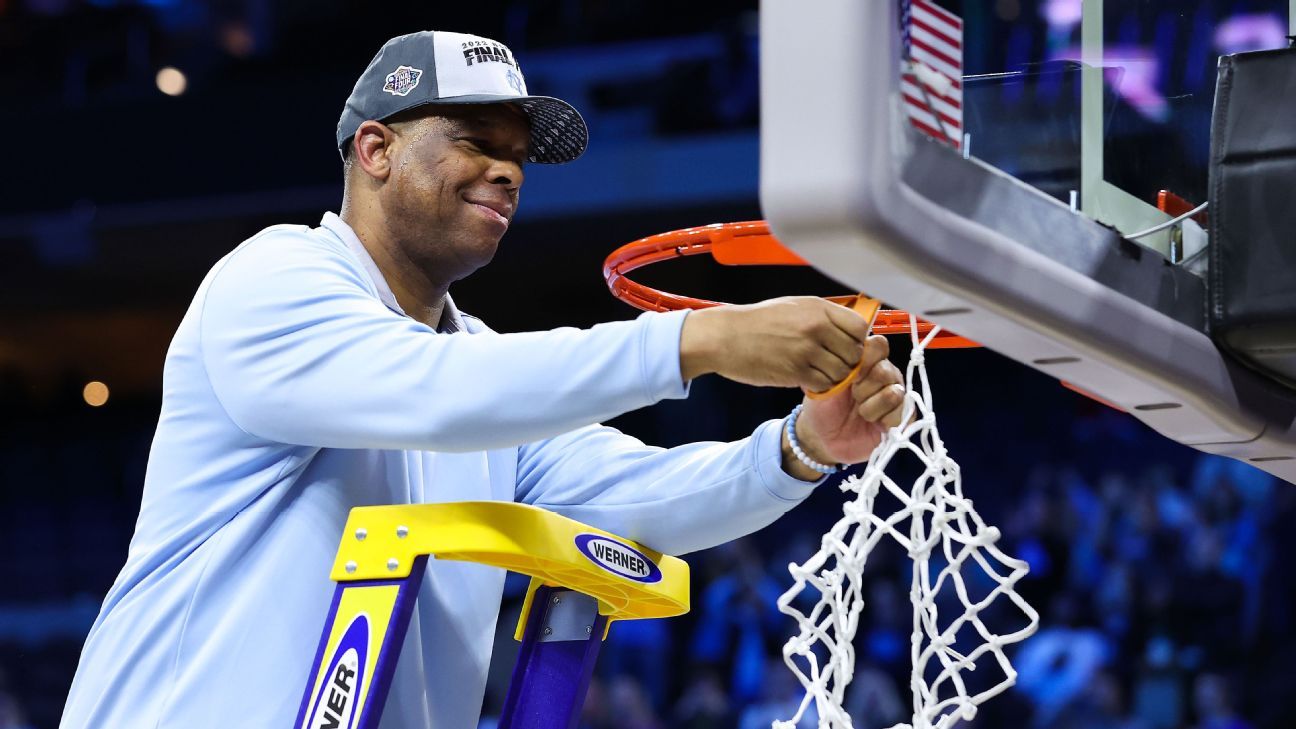Mike Krzyzewski isn’t walking through that door as Duke‘s head coach. Your defending champion is Kansas for the first time in 14 years.
When you see Villanova‘s Jay Wright next March, he’ll be covering the action as an analyst. If an analytically savvy former head coach with two national titles utters the words “You don’t need a 3 here,” we’ll have conclusive proof it really is a nonnegotiable clause in the contract of every announcer.
Welcome to the 2022-23 men’s college basketball season. Before it officially tips on Monday, we’re forecasting the highest possible highs and the lowest conceivable lows for every team in the AP top 25. Anything can happen in the next five months of college basketball, and we want to prepare you for the best, or worst when it comes to these teams.
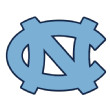
Best case: Armando Bacot makes voters say “Oscar who?” and wins the Wooden Award. Caleb Love and Pete Nance hit 3s left and right. Leaky Black shuts down every opponent’s featured scorer. The Tar Heels not only reach their fourth national title game in the past seven tournaments, they close the deal for the second time in that span and cut down the nets in Hubert Davis’ second year as a head coach.
Worst case: What if Northwestern transfer Nance isn’t this year’s Brady Manek after all? Manek arrived last season by way of Oklahoma as a turn-key volume shooter who had drained 37% of his 3s on 5.1 attempts per game. Nance’s career numbers clock in at 36% on 2.8 tries per outing.
More broadly, unless the tournament is canceled entirely, history suggests the worst case for any preseason No. 1 is losing in the round of 32.
The last preseason No. 1 to win the national title was … well, how about this: North Carolina in 2008-09.

Best case: Famed phenom of felicitous footwork Drew Timme compiles another year of voluminous 60%-plus shooting inside the arc. He will do something with his facial hair, up to and including shaving it regularly, that will generate feature stories. He’s helped along by a new second-leading scorer, Chattanooga transfer Malachi Smith. Rasir Bolton and Julian Strawther combine for 150 3s and 850 points. Gonzaga wins the title and quiets the “But what about their conference?” doubters once and for all — meaning, until next year.
Worst case: Where have you gone, Chet Holmgren? With your dad no longer shooting videos of every game, opponents are attacking the rim at will. This isn’t mere forecasting, mind you, it just happened. Tennessee converted 66% of its 2s and rang up 99 points in 76 possessions for an easy 19-point exhibition win last Friday night.
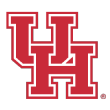
Best case: Houston is healthy, wealthy and wise. Heathy, unlike last season, when Marcus Sasser and Tramon Mark missed a combined total of 47 games. Wealthy in shot attempts after rebounding about 37% of their own misses. Wise to have hired Kelvin Sampson in 2014 and, related, to be jumping next season to a Big 12 that has produced the past two national champions. The Cougars are living their best case, thank you, and have been for the past eight years.
Worst case: Sasser turns out to be Houston’s lone perimeter threat and elite opponents hang tough when they force him off the line, or simply when he has an off night. The 1-for-20 effort the Sasser-less Cougars posted from beyond the arc in losing 50-44 to Villanova in the Elite Eight last season encourages defenses to make someone else beat them from out there.
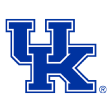
Best case: Pausing in his preparations for the 2023 national title game, John Calipari tweets out congratulations to the first player to win back-to-back Wooden Awards since Ralph Sampson almost 40 years ago. Meanwhile, Sahvir Wheeler calmly and deftly distributes the ball not only to Oscar “So who here is finishing second?” Tshiebwe but also to Jacob Toppin, Chris Livingston and Cason Wallace. For a second consecutive year, the Wildcats post far and away the highest number for points per possession in SEC play.
Worst case: Opposing coaching staffs disregard Doug Edert’s moustache and the seed Saint Peter’s drew in the 2022 tournament and watch the tape of that game. Yes, Tshiebwe makes Kentucky a superb defensive rebounding team — a trait that’s nullified completely when the opponent makes its first shot.
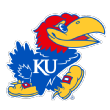
Best case: Kansas becomes the first repeat title winner since Florida in 2008 — due in part to a great Ochai Agbaji-scale leap forward in performance from Jalen Wilson. The junior becomes the latest in a long line of nascent All-American-level performers in Lawrence, stretching back to Thomas Robinson, who were just waiting for the older teammates to go away already. Texas Tech transfer Kevin McCullar Jr. steps in effortlessly alongside Wilson and provides needed strength on D.
Worst case: The Big 12 shoots better than last season’s 25.5% on its 3s against Kansas. This season turns out to be a year too soon for Bill Self and his group. Why? Gradey Dick, Ernest Udeh and M.J. Rice are Self’s first new recruits to figure this prominently since Devon Dotson, Quentin Grimes and Agabji did so in the absence of an injured Udoka Azubuike in 2018-19. The following season, the Jayhawks were 28-3 and on track for the overall No. 1 seed in the 2020 tournament.

Best case: LJ Cryer returns healthy and hungry. Along with Adam Flagler and Keyonte George, the junior leads what is plainly the nation’s best backcourt. West Virginia transfer Jalen Bridges embraces an opportunity to show his “Why isn’t he getting more looks?” offensive ratings as a Mountaineer were no fluke. Baylor finishes the regular season ranked No. 1 in the nation at KenPom for adjusted offense.
Worst case: Scott Drew’s defense takes a slight but noticeable step back from 2022. As with Kansas, the rubberband effect is no friend to the Bears on D. Unlike last season, the Big 12 does better than 27.7% on its 3s against Baylor.

Best case: New coach Jon Scheyer summons the old Duke magic. The Blue Devils thrive when a given year’s horde of elite recruits bonds, has fun, stays healthy, shares the ball and dominates à la 2019 (Zion Williamson, RJ Barrett, Cam Reddish, Tre Jones) or, of course, 2015 (Jahlil Okafor, Justise Winslow, Tyus Jones, Grayson Allen). The lack of a Jones brother proves to be no problem. Dereck Lively II, Dariq Whitehead, Kyle Filipowski and Tyrese Proctor team with singular old guy Jeremy Roach and Illinois transfer Jacob Grandison. Duke reaches a second straight Final Four for the first time since 1992.
Worst case: Surgery at the end of August to repair a broken bone in Whitehead’s right foot sidelines him for the first few games of the season. The Blue Devils find their chemistry and hit their stride later than they otherwise would have on offense. Meanwhile, the D is good, but not great, even when the rotation’s at full strength. Duke’s postseason looks less like 2015 or 2022 and more like 2016 (Sweet 16) or 2017 (round of 32).
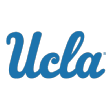
Best case: The Bruins tell their opponents and the world that just because you’ve seen this movie before doesn’t mean you can stop it. Tyger Campbell walks the ball up the floor. UCLA ranks at or near the bottom of the Pac-12 for tempo. Mick Cronin’s team almost never commits a turnover. This combined with average offensive rebounding means Jaime Jaquez Jr., Amari Bailey and their teammates put up a metric ton of shot attempts. It works yet again.
Worst case: Losing Johnny Juzang and Jules Bernard puts a dent in the Bruins’ scoring from the perimeter, even though Campbell carries a heavier possession load than ever. In the paint, 19-year-old Adem Bona is even better than advertised but still has his hands full filling many of the 1,100-plus minutes recorded last year by 22-year-old Myles Johnson and 24-year-old Cody Riley.
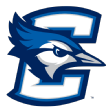
Best case: The Bluejays show that the close game they played against eventual national champion Kansas in the 2022 round of 32 was no accident. Creighton wins the Big East thanks in part to three players who weren’t even available against the Jayhawks: Ryan Nembhard (who was injured), Ryan Kalkbrenner (also injured) and Baylor Scheierman (played for South Dakota State at the time). Then again, Arthur Kaluma and Trey Alexander did play against KU, and put up a 24-12 double-double and nine assists, respectively.
Worst case: Scheierman cures CU’s previously woeful perimeter shooting at a stroke, but this offense continues to commit turnovers at an above-average rate in Big East play. As always, the Bluejays don’t fancy trying for offensive rebounds. The offense is improved since 2021-22 but still prone to dry spells.
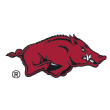
Best case: Arkansas makes a remarkable third consecutive Elite Eight thanks to the scoring of the electric Nick Smith Jr., uncanny accuracy at the line from Wichita State transfer Ricky Council IV and feisty offensive rebounding from Kamani Johnson. That last bit isn’t mere forecasting, mind you: The Razorbacks played an exhibition at Texas last weekend, and Johnson grabbed four offensive boards in 14 minutes.
Worst case: Arkansas underperforms because it can’t hold on to the ball — and, even when it does, can’t make shots. In the aforementioned exhibition against the Longhorns, Eric Musselman’s team eked out just 60 points in a 70-possession game, and lost by 30. While part of that can be chalked up to playing a true road game in October against a Chris Beard defense, the outcome suggests work to do.

Best case: Even with Josiah-Jordan James unavailable, Tennessee dismantled Gonzaga 99-80 in an exhibition played in Frisco, Texas, last weekend. 2022-23 is more of the same. More backcourt excellence from Zakai Zeigler and Santiago Vescovi (a combined 15 assists and three turnovers in 64 minutes against Gonzaga), more hard work on the glass from Olivier Nkamhoua (14 rebounds in 27 minutes) and, who knows, possibly more explosions from Tyreke Key coming off the bench (26 points).
Worst case: The Volunteers can’t quite break free from last season’s horrendous 2-point shooting. In fact two of the Vols’ better options inside the arc from 2021-22 are gone: Kennedy Chandler (50%) and John Fulkerson (52%).

Best case: Chris Beard’s second Texas team plays lights-out defense while blitzing opponents with a balanced and deep rotation featuring Timmy Allen, Marcus Carr, ESPN No. 4 recruit Dillon Mitchell, Iowa State transfer Tyrese Hunter and Arterio Morris. Just ask Arkansas.
Worst case: For a second season in a row, the Horns show they’re average and therefore susceptible on the glass at both ends of the floor. When 6-foot-9 Dylan Disu is not in the game, Texas customarily goes with five guys 6-7 and under.

Best case: A veteran Indiana team in 2022-23 turns out to fit the profile perfectly for what happens when “everyone’s back.” For major-conference teams that return a high (IU-like) level of possession-minutes from the previous season, most of the ensuing improvement comes on offense. Excellent news for the Hoosiers, who finished No. 10 in Big Ten play last season for points per possession. Trayce Jackson-Davis rampages and prevails in a ridiculously competitive Big Ten POY race. Xavier Johnson still hits 3s, but now at a significantly higher volume.
Worst case: The Hoosiers continue to view true road games with hard-earned trepidation — over the last three years, Indiana is 8-23 on opponents’ home floors; seven of IU’s eight road losses last season were decided by single digits, and two went to overtime. A number of heartbreaking “away” losses drop Mike Woodson’s team a couple seed lines.
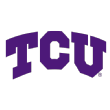
Best case: Ask Arizona. Last March, the Horned Frogs played the top-seeded Wildcats into overtime in the round of 32. All five of Jamie Dixon’s starters are back, and Mike Miles Jr. is your preseason Big 12 POY. The Frogs keep pounding the boards at both ends of the floor, Eddie Lampkin Jr. personally outrebounds entire teams on the offensive glass, and Miles and Damion Baugh confront opponents with not one but two versatile combo guards.
Worst case: TCU improves tremendously at taking care of the ball, lifting Dixon’s team all the way “up”… to only No. 8 or No. 9 in the rankings in Big 12 play. On possessions where there isn’t a turnover, this is an above-average offense. The worst case for Texas Christian is not recording enough of those possessions.
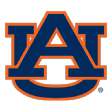
Best case: The Tigers keep right on going with Wendell Green Jr. and K.D. Johnson back from a team that won the SEC outright and earned a No. 2 seed. Bruce Pearl pushes the pace yet again, and new recruits Chance Westry and Yohan Traore fit in perfectly. Replacing a Jabari Smith is no small matter, but the Tigers do just that by improving their accuracy on 3s. Morehead State transfer Johni Broome even picks up where Walker Kessler left off on defense.
Worst case: Auburn really misses Kessler on defense. Unlike last season, opponents now actually make shots on occasion, even with Broome patrolling the paint. Last season, the Tigers held conference opponents to the lowest effective FG percentage the SEC has seen from any defense since Kentucky in 2015.

Best case: The Achilles tendon Justin Moore injured against Houston in the Elite Eight is healed. Caleb Daniels, Eric Dixon and Brandon Slater have career seasons. The Kyle Neptune era gets off to the kind of start Tommy Lloyd recorded last season at Arizona. Jay Wright continues to be spotted at Eagles games looking like the happiest and smartest retiree ever.
Worst case: Just like last season, the Big East still fares pretty well — not great, but average — against Villanova’s interior defense. The difference is, this year the league shoots better than 31.8% on its 3s against the Wildcats.

Best case: Arizona doesn’t skip a beat. Even with Bennedict Mathurin, Dalen Terry and Christian Koloko gone to the NBA, Tommy Lloyd uncorks another run at a conference title with the next Wildcats in line. Azuolas Tubelis is in the Pac-12 POY discussion all season, Kerr Kriisa shoots 3s like he did at the beginning of last season (11-of-24) and not the end (2-of-17), and Oumar Ballo posts a breakout junior year.
Worst case: A step back from going 33-4 and earning a No. 1 seed isn’t the end of the world, but without Mathurin, Terry and Koloko the Wildcats take a step back.

Best case: The Cavaliers are back. You knew this program couldn’t miss the tournament two seasons in a row, especially not with Tony Bennett returning his top six scorers. Jayden Gardner extends his run of prodigious 2-point scoring for a second year in Charlottesville. Reece Beekman follows through on the good 3-point shooting he showed in ACC play as a sophomore. Kihei Clark is still Kihei Clark.
Worst case: Virginia still isn’t really “Virginia” on defense. As surprising as it was to behold, the ‘Hoos were fairly normal on that side of the ball last season. Granted, there have been teams that improve markedly on D with pretty much all the same guys. But the list is fairly short: Wisconsin 2019 and Illinois 2020, among others.

Best case: No. 19? San Diego State proves the pollsters wrong with a vastly improved offense to go along with still another year of outstanding defense. Matt Bradley leads the Aztecs in scoring again, but this time he has more help. Seattle transfer Darrion Trammell excels, and TCU transfer Jaedon LeDee does the same. SDSU gets more production on offense from savvy and seasoned 24-year-old defender extraordinaire Nathan Mensah.
Worst case: This defense suffers due to minutes earned by players helping Bradley on offense.
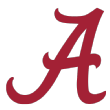
Best case: Jahvon Quinerly‘s ACL is as good as new. ESPN No. 9 recruit Brandon Miller adds immediate scoring from the wing. Alabama is once again the most perimeter-oriented major-conference team in the nation — only this time, the 3s fall.
Worst case: The 3s still don’t fall. The Crimson Tide manage to top last season’s 29% shooting from beyond the arc in SEC play, but not by much.

Best case: Will Richardson follows up on what should have been recognized as an All-Pac-12 senior year with a stellar fifth season. Transfers Quincy Guerrier (Syracuse), Jermaine Couisnard (South Carolina) and Keeshawn Barthelemy (Colorado) all blend in seamlessly. N’Faly Dante delivers on his promise, even as he shares minutes with ESPN top-10 recruit Kel’el Ware.
Worst case: The laptops are right: Oregon was overrated in the preseason at No. 21. A team that was average or close to it in just about every statistical category last season in Pac-12 play wasn’t built to make a great leap forward.
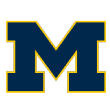
Best case: Hunter Dickinson says Oh no you don’t, Trayce Jackson-Davis or Zach Edey or anyone else. The 2023 Big Ten POY Award is mine. The Wolverines get back to their 2021 brand of defense, and the league no longer converts 53% of its 2s against Juwan Howard’s team. Princeton transfer Jaelin Llewellyn exports his 38% 3-point shooting intact to Ann Arbor. Terrance Williams II and Kobe Bufkin get their big breaks.
Worst case: UM does not recapture the 2021 glory on defense — a moment that happened with Franz Wagner, Mike Smith, Eli Brooks, Isaiah Livers and Dickinson — after all.

Best case: Kofi who? With Texas Tech transfer Terrence Shannon Jr., Baylor transfer Matthew Mayer, Coleman Hawkins, RJ Melendez and top-25 recruit Skyy Clark, Illinois has experience, scoring, defense and depth.
Worst case: Kofi Cockburn’s absence turns out to be a big deal both on offense, where he averaged eight made 2s per contest, and on defense, where he was very large.

Best case: With virtually every player returning from a team that beat Kansas last year, you knew Dayton would be top-25 good all season long. DaRon Holmes II wears out the rest of the Atlantic 10.
Worst case: One December evening after retiring for the night, UD coach Anthony Grant is visited by the ghost of A-10 seasons past. “Last year we had a team bringing everyone back too,” laments league commissioner Bernadette McGlade in a hushed whisper. “They were ranked No. 23 in the preseason and they didn’t make the tournament. Hear me, Anthony Grant!”
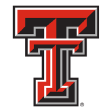
Best case: Mark Adams again guides the Red Raiders to another season of hegemonic defense. Kevin Obanor returns to his Oral Roberts roots as a 19 PPG scorer after averaging 10 last year in support of Bryson Williams.
Worst case: Even with the arrival of Oregon transfer and former Oklahoma starter De’Vion Harmon, Texas Tech still can’t make 3s.
